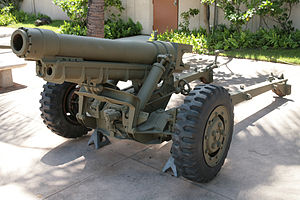M3 Howitzer
| 105 mm Howitzer M3 | |
|---|---|

A M3 howitzer outside the Army Museum in Honolulu, Hawaii.
|
|
| Type | Light Howitzer |
| Place of origin | United States |
| Service history | |
| In service | 1943–present |
| Used by | United States |
| Wars | World War II |
| Production history | |
| Designed | 1941 |
| Produced | 1943–1945 |
| No. built | 2,580 |
| Specifications | |
| Weight | 2,495 lb (1,130 kg) |
| Length | 12 ft 11 in (3.94 m) |
| Barrel length | Bore: 5 ft 6 in (1.68 m) L/16 Overall: 6 ft 2 in (1.88 m) L/17.9 |
| Width | 5 ft 7 in (1.70 m) |
| Height | 4 ft 2 in (1.27 m) |
|
|
|
| Shell | 105x372R |
| Caliber | 105 mm |
| Breech | Horizontal block |
| Recoil | Hydropneumatic, constant |
| Carriage | split trail |
| Elevation | -9° to 30° |
| Traverse | 45° |
| Rate of fire | Burst: 4 rpm Sustained: 2 rpm |
| Muzzle velocity | 1,020 ft/s (311 m/s) |
| Maximum firing range | HE: 8,300 yd (7,600 m) |
|
|
The 105 mm Howitzer M3 was a U.S. light howitzer designed for use by airborne troops. The gun utilized the barrel of the 105 mm Howitzer M2, shortened and fitted to a slightly modified split trail carriage of the 75 mm pack howitzer.
The howitzer was used by the U.S. Army during World War II. It was issued to airborne units and the cannon companies of infantry regiments.
The process of building airborne forces in 1941 led to a requirement for an air portable 105 mm howitzer. The weapon, initially designated T7, featured a barrel from the 105mm Howitzer M2, shortened by 27 inches (690 mm) and combined with a recoil system and carriage of the 75 mm field howitzer. A prototype reached trials at Aberdeen Proving Ground in March 1942.
The howitzer was designed to fire the same ammunition as the longer M2. However, it turned out that shorter barrel resulted in incomplete burning of the propelling charge. The problem could be solved by use of faster burning powder. Otherwise the design was considered acceptable and was standardized as 105 mm Howitzer M3 on Carriage M3. The carriage was soon succeeded by the M3A1, which had trails made from thicker plate. Even stronger tubular trails were designed, but never reached production.
The production started in February 1943 and continued until May 1944; an additional bunch was produced in April–June 1945.
Even though the M3 was not mentioned in the February 1944 Tables of Organization and Equipment (TO&E), shortly before the Normandy Airdrops some airborne divisions received a 105 mm glider field artillery battalion equipped with them as a supplement to their existing three 75 mm howitzer battalions (designated the M1A1 during World War II). 1/4 ton jeeps were used as prime movers. Later increased to four battalions, one, between 1943 and 1945, was converted to 105mm M3. The weapon was finally authorized as an option by the December 1944 TO&E and, by 1945, employed by all airborne divisions in the European Theater.
...
Wikipedia
